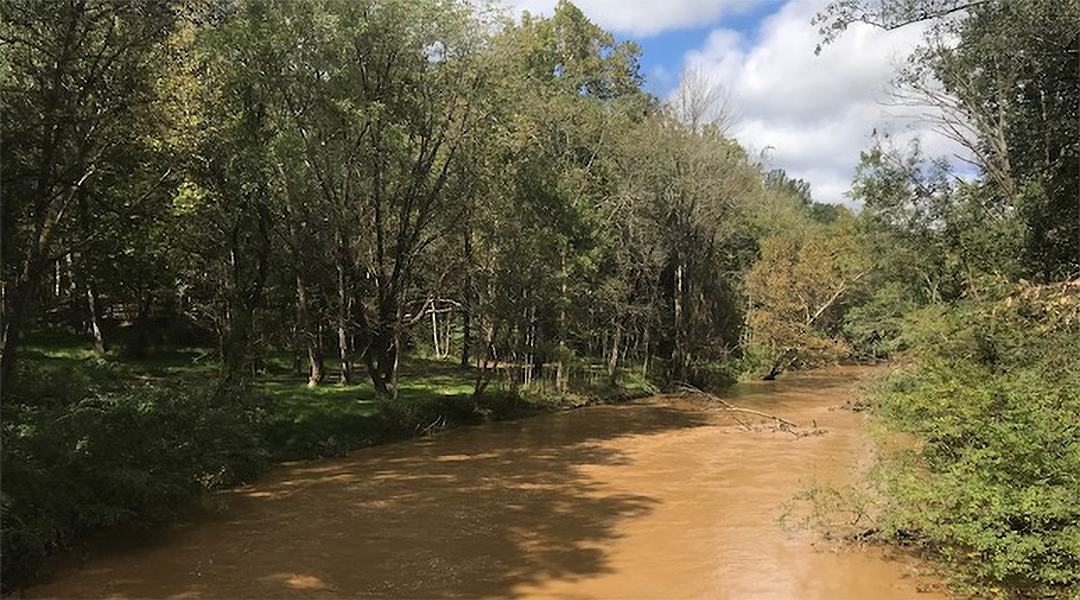Image creit: USGS
Resource managers around the world are developing strategies to reduce the impacts of excessive fine sediment on local streams and downstream ecosystems. In the mid-Atlantic region of the U.S., a partnership of federal, state, and local governments — the Chesapeake Bay Program (CBP) — is working to implement management actions that would reduce sediment transport to Chesapeake Bay by 20%.
In addition to Chesapeake Bay, numerous streams in the watershed are ecologically impaired due to excess sediment and are subject to individual regulations. These and other efforts to manage excess sediment would benefit from a synthesis of the available science on sediment sources, transport, fate, impacts, and management.
The relatively well-studied Chesapeake region is typical of diverse temperate landscapes. The state-of-the-art science on sediment dynamics has recently been reviewed for the Chesapeake Bay watershed with the goal of improving management practices to reduce fine-grained sediment from entering waterways both in Chesapeake and in other affected areas.
“The CBP partnership has invested in sediment science over the past several decades, making the Chesapeake an important learning opportunity for how to better manage sediment,” said Dr. Greg Noe, the lead author of the review in WIREs Water, which covers decades of science regarding sediment dynamics.
Rates of erosion and sediment delivery are affected by current climate and land management, but today’s environment was shaped by the underlying geology, past climate, and historical land use. Fine sediment can also degrade the health of aquatic life, especially stream macroinvertebrates and fish, and other important living resources in the downstream Chesapeake Bay.
“Excessive sediment is responsible for destroying high-quality habitat in both the watershed and estuary, especially for vulnerable organisms such as trout, oysters, and underwater grasses,” stated Dr. Matt Cashman, a co-author on the study. Sediment is an important vector for the delivery and storage of phosphorus and contaminants to downstream ecosystems.
Important sources of sediment in the Chesapeake include the Piedmont physiographic region, urban and agriculture land use, and streambank erosion of headwater streams, whereas floodplain trapping is important along larger streams and rivers. Rates of sediment export differ widely across the Chesapeake watershed, with little evidence yet of widespread declines over time.
Best management practices (BMPs) on the uplands and in channels are actively being implemented and are expected to lead to decreased sediment loading. However, reworking legacy sediment stored in stream valleys, with potentially long storage times, can delay and complicate the detection of BMPs’ effects on sediment loads.
According to Dr. Allen Gellis, another of the study’s authors, “In order to reduce sediment it is imperative to identify the significant sediment sources.” An improved understanding of sediment sources, storage areas, and transport lag times can help target choices of BMP types and locations to better manage sediment problems — for both local streams and receiving waters.
Several new technologies and approaches under development that can provide better targeted information to individual watersheds and stream reaches include light detection and ranging (LIDAR), drones, and sediment source fingerprinting techniques. Although the researchers focused on Chesapeake Bay watershed and estuary, their findings are thought to be applicable to other locations with high sediment loads and excess fine sediment impacting aquatic ecosystems, and where management of these issues is a priority.
“The focus of Chesapeake Bay restoration is shifting towards non-point source control and increased understanding of natural and anthropogenic sediment processes as the foundation for planning effective management strategies for both sediment and nutrients,” author Gary Shenk stated.
Written by: Gregory B. Noe, Matthew J. Cashman, Katie Skalak, Allen Gellis, Kristina G. Hopkins, Doug Moyer, James Webber, Adam Benthem, Kelly Maloney, John Brakebill, Andrew Sekellick, Mike Langland, Qian Zhang, Gary Shenk, Jeni Keisman, and Cliff Hupp
Reference: Gregory B. Noe et al. ‘Sediment dynamics and implications for management: State of the science from long-term research in the Chesapeake Bay watershed, USA,’ WIREs Water (2020). DOI: 10.1002/wat2.1454














